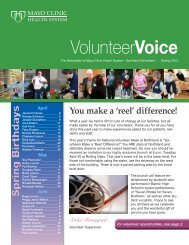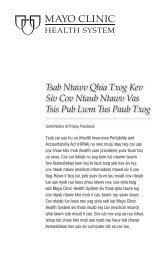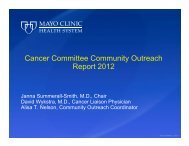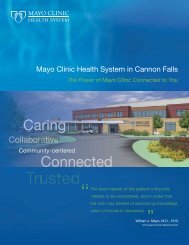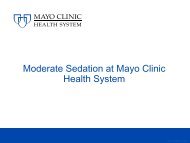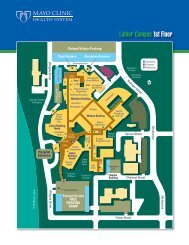Albert J. and Judith A. Dunlap Cancer Center at Mayo Clinic Health ...
Albert J. and Judith A. Dunlap Cancer Center at Mayo Clinic Health ...
Albert J. and Judith A. Dunlap Cancer Center at Mayo Clinic Health ...
You also want an ePaper? Increase the reach of your titles
YUMPU automatically turns print PDFs into web optimized ePapers that Google loves.
o Research/<strong>Clinic</strong>al Trials<br />
o Support Groups<br />
• MCHS <strong>Cancer</strong> Registry<br />
o Annual Analytic Case Report<br />
o The Function of the <strong>Mayo</strong> <strong>Clinic</strong> <strong>Health</strong> System <strong>Cancer</strong> Registry<br />
o 2011 Analytic Cases by Site, Gender <strong>and</strong> Stage<br />
• Contact Inform<strong>at</strong>ion<br />
o <strong>Cancer</strong> Committee<br />
• Commission on <strong>Cancer</strong> (CoC) Survey: Spring 2013<br />
• 2012 Membership<br />
Breast <strong>Cancer</strong> Outcome Analysis & Compar<strong>at</strong>ive D<strong>at</strong>a Report — 2012<br />
The American College of Surgeons’ Commission on <strong>Cancer</strong> (CoC) <strong>and</strong> N<strong>at</strong>ional Accredit<strong>at</strong>ion Program for<br />
Breast <strong>Center</strong>s (NAPBC) requires annual performance r<strong>at</strong>es to be reported for six quality measures identified by<br />
the NAPBC. Performance <strong>and</strong> outcomes for these measures are evalu<strong>at</strong>ed annually by <strong>Mayo</strong> <strong>Clinic</strong> <strong>Health</strong><br />
System in Eau Claire <strong>and</strong> breast program leadership. Breast cancer d<strong>at</strong>a evalu<strong>at</strong>ed for this report is from the<br />
<strong>Mayo</strong> <strong>Clinic</strong> <strong>Health</strong> System in Eau Claire <strong>Cancer</strong> Registry’s 2011 analytic caseload.<br />
1. Basic epidemiology.<br />
In 2012, it is estim<strong>at</strong>ed th<strong>at</strong> among U.S. women there will be 226,870 new cases of invasive breast cancer<br />
(includes new cases of primary breast cancer among survivors, but not recurrence of original breast cancer<br />
among survivors). Also, there will be 63,300 new cases of in situ breast cancer (includes ductal carcinoma in<br />
situ (DCIS) <strong>and</strong> lobular carcinoma in situ (LCIS), of which about 85 percent will be DCIS. DCIS is a<br />
noninvasive breast cancer, <strong>and</strong> LCIS is a condition th<strong>at</strong> increases the risk of invasive breast cancer. There will<br />
be 39,510 women who die of breast cancer.<br />
2. Local epidemiology as to cases within our group.<br />
Within 2011, <strong>Mayo</strong> <strong>Clinic</strong> <strong>Health</strong> System in Eau Claire diagnosed <strong>and</strong>/or provided first-course tre<strong>at</strong>ments, often<br />
referred to as the analytic caseload to 127 breast p<strong>at</strong>ients per the <strong>Mayo</strong> <strong>Clinic</strong> <strong>Health</strong> System in Eau Claire<br />
<strong>Cancer</strong> Registry. The most commonly used method of disease distribution for studies, <strong>and</strong> in compliance with<br />
n<strong>at</strong>ional guidelines, is the American Joint Committee on <strong>Cancer</strong> (AJCC) staging, the process th<strong>at</strong> describes the<br />
extent or severity of an individual’s cancer based on the extent of the original (primary) <strong>and</strong> the extent of spread<br />
in the body. The 2011 breakdown is as follows:<br />
<strong>Mayo</strong> <strong>Clinic</strong> <strong>Health</strong> System in Eau Claire 2011 Analytic Breast Cases by AJCC Stage<br />
AJCC<br />
Stage<br />
TOTAL 0 I II III IV UNK N/A<br />
BREAST 127 21 53 33 10 5 3 2<br />
The stage <strong>at</strong> which the cancer is diagnosed is the best predictor of a woman’s chance of surviving the disease.<br />
Early stage, Stage 0–II requires less aggressive, life-interrupting tre<strong>at</strong>ments to ensure surviving the diagnosis.<br />
Twenty-one cases were Stage 0, 53 cases were Stage I <strong>and</strong> 33 cases were Stage II. Thus, over 80 percent of the







